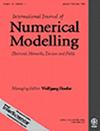Coarse and Fine Encoding Genetic Algorithm Assisted Parameter Extraction Approach for Quasi-Empirical Equivalent Circuit Model of Fan-Out Coplanar Waveguide
Abstract
In this article, a genetic algorithm based on coarse and fine encoding is proposed to assist the parameter extraction method of the coplanar waveguide model. First, an equivalent circuit model is proposed to accurately characterize the electrical characteristic parameters of the coplanar waveguide. The proposed quasi-empirical equivalent circuit model not only has a certain physical meaning but can also realize the solution of the nonlinear relationship between the device performance parameters and the dimensional structure parameters. Then, a single-step genetic algorithm is proposed to accelerate the parameter extraction based on the proposed semi-empirical model of the coplanar waveguide. On this basis, a coarse and fine encoding genetic algorithm is proposed to accelerate the parameter extraction. The proposed parameter extraction method not only avoids the problem of inaccurate element values that may be caused by artificially determining partial parameter values, but also omits the process of solving simultaneous equations. It can also avoid the problem of insufficient solution accuracy caused by the large order-of-magnitude difference between the values of equivalent circuit elements. Therefore, the quasi-empirical equivalent circuit model and the parameter extraction method accelerated by the coarse and fine encoding genetic algorithm proposed can achieve accurate and efficient modeling of devices.

 求助内容:
求助内容: 应助结果提醒方式:
应助结果提醒方式:


